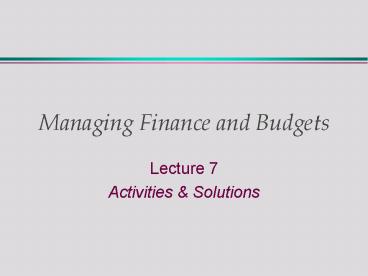Managing Finance and Budgets - PowerPoint PPT Presentation
1 / 10
Title:
Managing Finance and Budgets
Description:
PROJECT ONE PROJECT TWO. Investment 300,000 500,000 ... However the second machine promises greater return on our investment in the long run. ... – PowerPoint PPT presentation
Number of Views:33
Avg rating:3.0/5.0
Title: Managing Finance and Budgets
1
Managing Finance and Budgets
- Lecture 7
- Activities Solutions
2
Accounting Rate of Return Further Example
- PROJECT ONE PROJECT TWO
- Investment 300,000 500,000
- Cashflow Depn Net Profit
Cashflow Depn Net Profit - Year 1 90,000 60,000
30,000 120,000 100,000 20,000 - Year 2 160,000 60,000 100,000
140,000 100,000 40,000 - Year 3 120,000 60,000
60,000 160,000 100,000 60,000 - Year 4 70,000 60,000
10,000 240,000 100,000 140,000 - Year 5 70,000 60,000
10,000 320,000 100,000 220,000 - Totals 510,000 300,000 210,000
980,000 500,000 480,000 - ARR Average profit/Average
investment - (210,000/5)/ (300,000/2)
28 (480,000/5)/(500,000)/2 38.4
In this case, the depreciation has been included
as part of the Net Profit calculation
3
Activity One
- A company is considering investing in either of
two new machines which will help to increase its
production. The first machine will cost 240,000,
and the company estimates that it will have a
working life of 5 years. The second machine will
cost 360,000 and have a working life of 6 years.
The net positive cash-flows as a result of cost
savings from the new machine are shown below.
Calculate the payback period and Accounting Rate
of returns for each of the machines. - Machine 1 Net Cash-flows 90,000/yr
for first 3 years - 50,000/yr for remaining 2 years
- Machine 2 Net Cash-flows 100,000 Year 1
- 110,000 Years 2
- 120,000 Years 3 and 4
- 90,000 Years 5 and 6
4
Activity One Solution Part 1
- Machine 1
- Cost 240K Life 5 years
- Net Cash-flows 90K /yr for first 3 years
- 50K /yr for remaining 2 years
- ARR
- Average Profit (3 x 90000) (2 x 50000) -
240000 ? 5 26000 - Average Investment (240000 0) ? 5 48000
- ARR 26000/48000 54.2
- PP
- In the first two years, Total Cash flow
180000, - so the PP will occur sometime in year three
- Proportion of year three (240000-180000)/90000
8 months - PP 2 years and 8 months
5
Activity One Solution Part 2
- Machine 2
- Cost 360K Life 6 years
- Net Cash-flows 100K, 110K, 120K, 120K,
90K, 90K - ARR
- Average Profit (100000110000 120000x2
90000x2) - 360000 ? 6 45000 - Average Investment (360000 0) ? 6 60000
- ARR 45000/60000 75
- PP
- In the first three years, Total Cash flow
330000, - so the PP will occur sometime in year four
- Proportion of year four (360000-330000)/120000
3 months - PP 3 years and 3 months
6
Activity One -Summary
- Machine 1 ARR 45.8 PP 2 years 8 months
- Machine 2 ARR 75 PP 3 years 3 months
- Analysis
- If we opt for the Machine 1, it will cost less,
and we will recoup our initial expenditure 7
months sooner. However the second machine
promises greater return on our investment in the
long run. - Decision
- If the company can secure the finances (e.g.
long term loan over 4 years ), then Machine 2
represents a much better investment. If finances
are a problem, then we may have to settle for
Machine 1.
7
Activity Two
- For the scenario described in Activity One,
calculate a Net Present Value for each of the two
machines, using a Discount Rate of 10 and a
Discount Rate of 20. The Discount Factors at the
two rates are shown below - 10 20
- Year 1 0.909 0.833
- Year 2 0.826 0.694
- Year 3 0.751 0.579
- Year 4 0.683 0.482
- Year 5 0.621 0.402
- Year 6 0.565 0.335
8
Activity Two Solution (1)
- MACHINE ONE MACHINE TWO
- Discount
Discount - Cashflow Factor DCF
Cashflow Factor DCF - Invmnt -240,000 1 -240,000
360,000- 1 360,000- - Year 1 90,000 0.909 81,810
100,000 0.909 90,900 - Year 2 90,000 0.826 74,340
110,000 0.826 90,860 - Year 3 90,000 0.751 67,590
120,000 0.751 90,120 - Year 4 50,000 0.683 34,150
120,000 0.683 81,960 - Year 5 50,000 0.621 31,050
90,000 0.621 55,890 - Year 6
90,000 0.565
50,850 - Totals
48,940
100,580 - The above figures use a Discount Rate of 10
9
Activity Two Solution (2)
- MACHINE ONE MACHINE TWO
- Discount
Discount - Cashflow Factor DCF
Cashflow Factor DCF - Invmnt -240,000 1 -240,000
360,000- 1 360,000- - Year 1 90,000 0.833 74,970
100,000 0.833 83,300 - Year 2 90,000 0.694 62,460
110,000 0.694 76,340 - Year 3 90,000 0.579 52,110
120,000 0.579 69,480 - Year 4 50,000 0.482 24,100
120,000 0.482 57,840 - Year 5 50,000 0.402 20,100
90,000 0.402 36,180 - Year 6
90,000 0.335
30,150 - Totals
-6,260
-6,710 - The above figures use a Discount Rate of 20
10
Activity Two Solution Summary
- DF 10 DF 20
- NPV of Machine 1 48,940 -6,260
- NPV of Machine 2 100,580 -6,710
- Analysis
- If the value of money is decreasing at 10 per
annum (low risk, low inflation, low interest),
then Machine 2 is a much better proposition,
earning over 50K more. - However, if the value of money is decreasing at
20 per annum (high risk, high inflation, high
interest) then Machine 1 is a slightly better
proposition, as its loss is somewhat less.
However, the value of purchasing any machine
under these circumstances is questionable.































